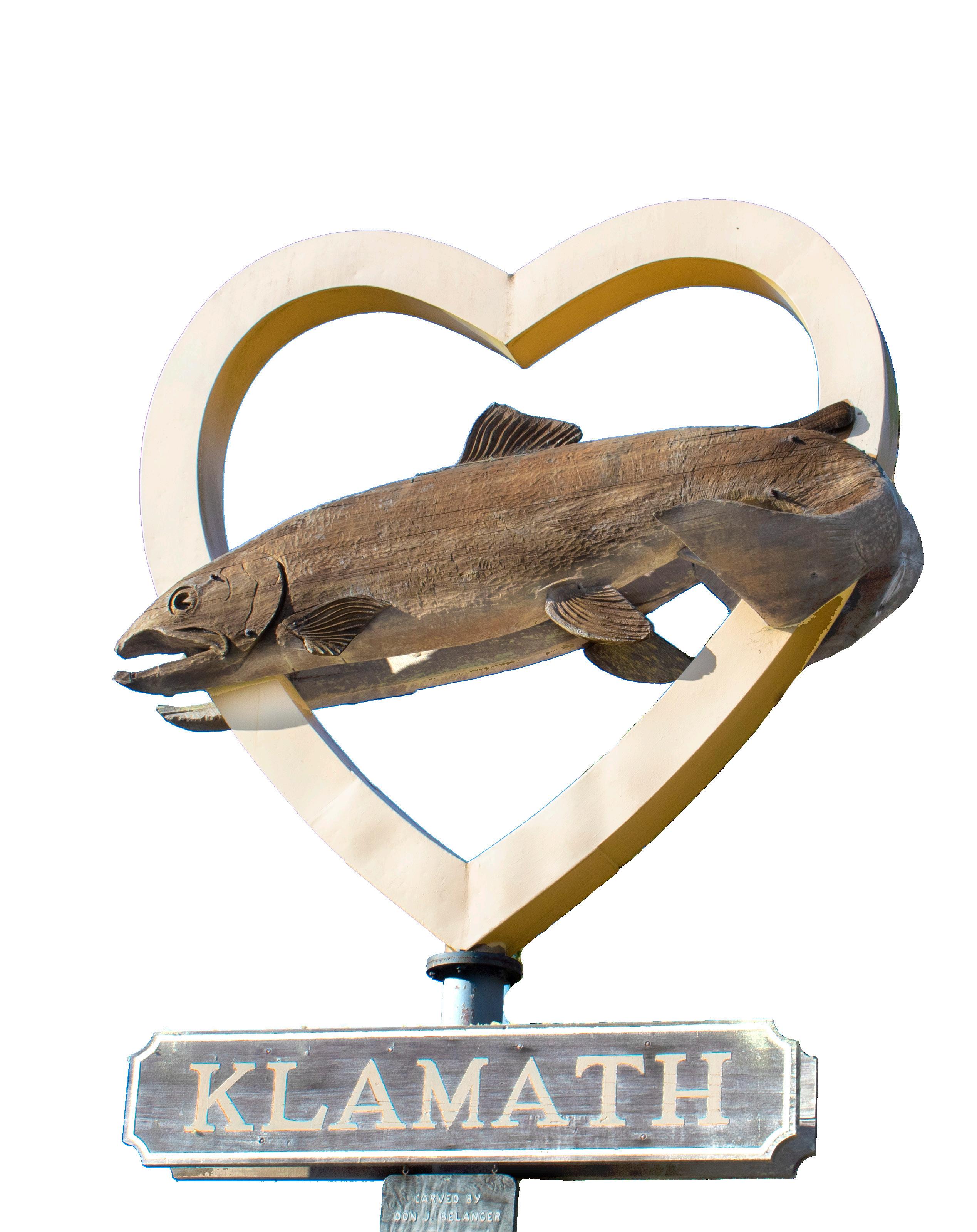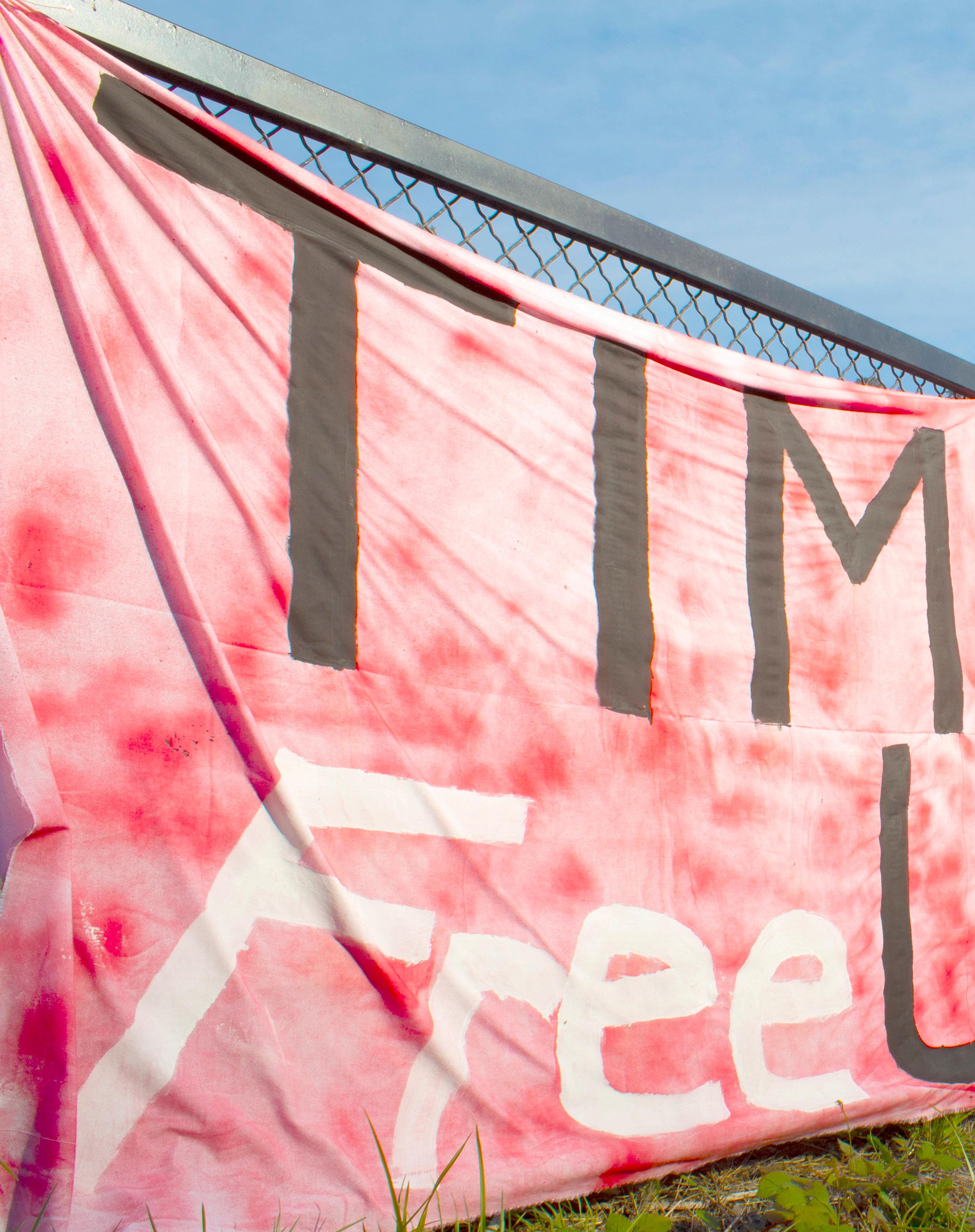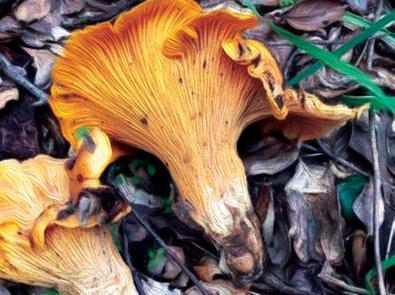
16 minute read
THE END OF THE DAM AGE: INDIGENOUS PERSPECTIVES FOR A FRUITFUL FUTURE
from Osprey fall 2020
BANNERS FROM KLAMATH ACTIVISTS ARE HUNG ALONG THE FENCE LINE OUTSIDE OF THE KLAMATH RESERVATION IN KLAMATH, CALIFORNIA.
CALL TO ACTION The Yurok tribe recently extended human rights to an ecosystem--The Klamath River. This acknowledgment of innate rights to life gives the Klamath ecosystem legal standing in a tribal court of law, but this isn’t the only big news about the Klamath River. The Klamath dam removal project proposes the single largest fish restoration project to ever happen in the world. The dams on the Klamath primed for removal are owned by the Berkshire Hathaway foundation and PacifiCorp, these dams are outdated and have been due for relicensing. PacifiCorp, the Federal Energy Regulatory Commission (FERC), Yurok and Karuk tribal councils, and multiple independent organizations have been working together to remove these dams and restore the Klamath river ecosystem. Regina Chichizola is co-director of Save California Salmon Foundation and has been personally involved with Klamath river water issues consistently. “We’ve been working on this dam removal project for sixteen years now,” said Chichizola. The Klamath dam removal project has been a long time coming. The original plans proposed deconstruction to start in 2020 but bureaucratic stalls have periodically paused the process. Should everything fall into place with the federal approval of licensing, the deconstruction, and the restoration plan, we will see preparations and work beginning in 2022. Dave Meurer, community liaison for the Klamath River Renewal Corporation is hopeful. “Right now, the state of California, the state of Oregon, PacifiCorp, the Yurok tribe, and the Karuk tribe are meeting and trying to hammer out a pathway forward,” said Meurer. On November 17th, 2020 the main players within this historical project proposed an agreement to directly address FERC’s concerns. Proposing that the California and Oregon governments become co-licensees within the dam removal process with Pacificorp and the Klamath River Renewal Corporation (KRRC). This collaboration hopes to continue the forward momentum on the dam removal project, but it still needs federal approval before construction finally starts. The Klamath dam removal project sets out to restore the ecosystem while the rights of the
Advertisement


generations. The project is putting indigenous perspectives on the environmental map, advancing the conversation on climate change and placing indigenous cultural values and innovation at the forefront of environmental issues. The Yurok and the Karuk tribes are leading the conversation for environmental restoration, management and policy changes within California. The indigenous prerogative towards amicable treatment of ecosystems is gaining attention with climate action policy. The Yurok tribal law now recognizes the legal personhood of the river, this recognition is precedent setting and arrives just in time. Dr. Cutcha Risling Baldy, professor and department chair of the Native American Studies department at HSU, has lived around the Klamath all her life. “The Klamath Dam removal became this righteous call to action, the only way we are going to be able to save this world is through these types of actions that rectify a settler colonial system that was set up only for profit,” said Risling Baldy. As time moves forward dams are only growing more dangerous and costly to maintain. While some dams are necessary for water diversion, they greatly disrupt river ecosystems. Alternative energy sources are also making Western water management a technology of the past. This change places responsibility on us to remove the shackles of capitalism’s past and create new concepts about our environmental relationships. “When people are not the center of the decision making, then we make very different decisions about what that means for our policy,” said Risling Baldy. Environmental stewardship is everyone’s responsibility. Ideally, it is a progressive movement forward, maintaining or repairing the environment for those who come after, so they too may live comfortably. This responsibility transcends species. Take care of the world and trust it will take care of you. Recognize where you fit within the landscape, respect nature and receive that in return. In the traditional Yurok creation story, Earth starts life as a lonely rock floating within the universe. Its tears became the oceans and, from this, the world was created. The Yurok creation story states that Spirit People constructed the earth and the ecosystems. The Spirit People provide salmon for the Klamath to sustain the Yurok and to ensure a prosperous environment.
“Yurok people, Hupa people,


A VIEW OF THE KLAMATH INLET FROM THE OVERLOOK TRAIL IN KLAMATH, CALIFORNIA
Karuk people -- we identify ourselves as river people, as salmon people,” said Kaitlin Reed, an assistant professor at HSU and a Yurok tribal member. Within the formation of the Earth, the Spirit People create a relationship between the Yurok and the salmon. This relationship promotes coexistence and harmony within the ecosystem. The importance of this relationship is stressed within other Yurok teachings, warning of the consequences of imbalance should the Klamath be altered or neglected. “There’s this thing called natural law, there are rules that you have to abide by within an ecosystem or the ecosystem collapses,” said Reed. The Yurok people believe that if the salmon perish then there is no need for Yurok people. As long as the Yurok take care and protect the river for the salmon, the salmon will provide prosperity for the Yurok. This message emphasizes the importance of sustainable living practices to ensure a prosperous ecosystem that provides life for all.
HISTORY OF THE KLAMATH RIVER ECOSYSTEM
The Klamath River stretches across the border of Northern California and Southern Oregon with over two hundred miles of clear flowing water connecting the Klamath Mountains to the Pacific Ocean. This river system provides life to the Klamath National Forest which houses over one hundred thousand square miles of the world’s old growth forest. This river system is the second largest in California and, historically speaking, the Klamath river was the third most productive salmon river system in the United States. The ebb and flow of the Klamath river cuts a pathway through coastal forest, making room for life, a home for numerous species of flora and fauna. There are a large number of other species, both plant and animal, that live and contribute to this ecosystem. The Klamath River’s historically large salmon runs transport an abundance of nutrients from the ocean to the mountains, and provide the foundation for the development of old growth forests. Old growth forests have a varied structure, they produce numerous canopy layers which house and increase the amount of biodiversity. These forests create topsoil instead of eroding it, providing more habitat for mycelium and other, smaller organisms. More greenhouse gasses are retained in old growth forests than any other wooded area. These forests’ multilayered structures are also responsible for improving water and air quality. But old growth forests aren’t a thing of the past, they can also be restored like any other ecosystem, just not in one lifetime. Ecosystem restoration is an essential part of climate action, one that indigenous peoples have always valued and continue to advocate for. Indigenous stewardship of the Klamath and the lands they inhabit has been proven effective. But for the last 150 years Indigenous culture and way of life towards land have been suppressed and replaced with Western land management practices. These practices contribute to increasingly devastating climate change, including the California Wildfires. “There’s a lot of reasons why we’re having a lot of horrific fires in California, most of it has to do with this history of land dispossession of Native peoples,” said Risling Baldy. Emphasizing the need for a new perspective and stable organization when it comes to environmental relations.


A CALIFORNIA ORANGE BELLIED NEWT KLAMATH, CALIFORNIA

The Yurok and Karuk have coexisted with the Klamath since time immemorial, managing the land and ecosystem to support their livelihoods. The Klamath sustained civilizations for centuries, providing abundance for all. In return these people cared for and protected the land for future generations to enjoy its prosperity. “We think of economy as something with paper currency. We had an enormous economy, literally millions of salmon came through that river system every single year, enough to feed everybody,” said Reed. The Yurok and the Karuk have maintained a relationship within this ecosystem and it is deeply rooted within their culture. This emphasizes the protection of the Klamath, the water and the salmon, and in doing so, their way of life. The Yurok and the Karuk have extended their viewpoints to include and legally recognize an ecosystem’s personhood within tribal law, aiding in the fight for Indigenous environmental management and resource regulation. This foothold has given Indigenous people the attention of the public when it comes to their perspectives towards the land. The voices of the Yurok and the Karuk people have set a precedent for climate action and ecological restoration that is heard all over the country. “It’s not even giving, it’s

A VIEW OF THE KLAMATH RIVER FROM REQUA, CALIFORNIA

acknowledging that these rights exist and saying what is our responsibility to those rights,” said Risling Baldy.
WESTERN INVOLVEMENT/ CURRENT STATE OF THE KLAMATH
The Klamath sustained civilizations for centuries before Western involvement, determined to electrify and industrialize society, left the river choked up and barren. The ecosystem disruption within the Klamath is far reaching, and its connection to Western land management practices is ever present. While resources were once viewed as expendable, perspectives have changed. “Control and commodification of water doesn’t allow for a healthy ecosystem. It prioritizes the needs of profit-based extraction over traditional subsistence fishermen and, of course, salmon,” said Reed. Dam removal and the ecosystem restoration will be foundational to correcting past mistakes, directly benefiting future generations. This profound development will repair relationships, both human and otherwise, in the process of moving forward. Western mentality dominated and extracted resources for financial gain. People who built the dams were profit hungry, making the land work for them and achieving financial success in the process. The dams largely act as concrete colonial monuments, dominating mighty rivers, stopping ecological flow and creating problems unforeseen by the creators of the dam. While dams provide hydroelectric power and divert water for human use, they also inhibit the river’s natural flow. During low water years this lack of water causes a loss of habitat for fish populations. This brings fish in closer proximity to each other, heightening the competition for resources which creates an ideal habitat for disease to spread. All of these factors have resulted in the steady decline of salmon and other fish populations within the Klamath since dam construction. One cannot pursue serious restoration of the Klamath river without addressing foundational issues such as dam removal. Lack of water in a river contributes to toxic algae blooms, declines in fish population, and other ecological losses. The fish are so absent within recent years that this marks the first time that tribes are unable to legally fish in the river even for personal use. “What Yurok elders say is that as long as the river is sick the

AN TRADITIONAL INDIGENOUS METHOD FOR PRESERVING SALMON IN KLAMATH, CALIFORNIA.

people will never be healthy,” said Reed. The Klamath has closed its fish runs and the Yurok people have canceled their ceremonies. The water within the Klamath has grown stagnant and the salmon have not returned to spawn. It’s time to give the water back to the river.
THE IMPORTANCE OF SALMON
The Yurok and Karuk see the importance of maintaining healthy salmon runs as inherent within indigenous culture and knowledge. The indigenous people are stewards to the Klamath. Their way of life depends on the Klamath’s sustainability and vice versa. Indigenous people see it upon themselves to protect the river so the salmon can live and migrate, feeding multitudes of creatures. Salmon and other fish are keystone species, meaning that these creatures influence the survival of other wildlife. Salmon populations are largely depended upon by other animals for food. As these populations continue to dwindle the entire ecosystem is affected by the absence of a vital part of the environment. Diminishing fish populations have caused the Klamath River ecosystem to change drastically. “As Native people they always refer to us as the miners’ canary. What happens in Native communities is the warning about what’s going to be happening on a much bigger scale if it continues the way that it is,” said Risling Baldy.
ELWAH DAM REMOVAL
One example of ecological restoration is the Elwah dam removal, a project in Washington approved in 2011. The Elwah river had two dams built within its waters during the 1900’s to support settler towns. These dams clogged the natural arteries of the planet and the ecosystem began to decline. Much like the Klamath, the Elwah also produced historic runs of fish, providing nutrients for the ecosystem. With the introduction of the dams, these fish runs were reduced to nearly nothing and the ecosystem greatly suffered. The first dam was removed


from the Elwah in 2012 and the second dam was removed in 2014. While each dam removal only took around six months to complete, the space in between removal allowed for sediment to flow freely without becoming concentrated in higher than ideal levels within the river. The release of this sediment has changed the look of the estuary and restored long lost hatchery habitat within the mouth of the Elwah. The summer steelhead were thought to be basically extinct before the dam removal began. Eight years after the project took place and the necessary steps were taken to ensure the healing of the river system, scientists saw the summer steelhead unexpectedly resurge within the Elwah. Numbers recorded suggest that The Elwah river now contains the largest population of summer steelhead among all of Washington’s coastal river systems.
HUMAN RESPONSIBILITY AND ECOSYSTEM RECOGNITION
Just as dam construction was necessary during industrialization, dam removal will be this century’s progression towards a third industrial revolution. It is hopeful to think indigenous perspectives will be leading the discussion behind climate action and ecological restoration. When the Klamath Dam Removal and subsequent restoration project comes to fruition, we will see the revival of an ecosystem that has been obstructed for over a hundred years. With this deconstruction process we will finally begin to tear down the walls that clog up not just rivers but the lines of communication that discuss ecological relationships. Humboldt County has a long-standing indigenous foothold and, within the last few years, has been one of the first regions within the United States to recognize and begin reparations toward indigenous relations. The acknowledgment of rights for all living entities, big and small, creates a shared moral foundation in which confluence provides solutions for future generations to come, ultimately healing the deep wounds that manifest destiny has inflicted. The Klamath river eco-
system is one of reciprocity. This foundational principle recognizes the inherent rights to life that we all share, plant, animal and ecosystems alike. Yurok and Karuk value systems are reflective within their tribal law. This innovative perspective changes conversations around environmental relations. This change can begin the process of healing between not only humans and environments, but indigenous and western relationships. “We’ve been taught from the very beginning of our creation that we have a responsibility and that’s what humanity is, a responsibility, not a right,” said Risling Baldy.


BANNERS FROM KLAMATH ACTIVISTS ARE HUNG ALONG THE FENCE LINE OUTSIDE OF THE KLAMATH RESERVATION.


foraging in humb oldt county

blackberries: If you’ve spent a good amount of time in Humboldt, you’ll know that blackberry bushes are just about everywhere. A lot of the blackberries found here are Himilayan blackberries which are actually an invasive species native to Armenia and Iran, but they are still safe to eat and delicious! The stalks of these blackberry bushes tend to be a deep red color with lots of thorns and the leaves are heart-shaped with serrated edges. Berries can be seen starting around April to July. WARNING
This spread is strictly informational and is not intended to be used as a guide. Learning how to forage safely is a skill that requires practice, especially for mushrooms. Always forage in clean areas without agricultural runoff. Clean all your foraged goods thoroughly. Licensing may be required when hunting or fishing so be sure to acquire the appropriate paperwork before engaging in.
Be sure to forage or hunt in areas that you are allowed to as well as clean areas that won’t have any change of agricultural or pollutant runoff that may affect the quality of the foods being foraged.



golden chanterelles: There are many different species of chanterelle mushrooms and they all mostly grow around the summertime, after it rains. They grow on the forest floor and are easy to spot because of their vibrant yellow-orange hue. They often grow as individual mushrooms. If you look at the underside of one, you’ll see that they have thick, forked ridges; not true gills. These ridges run down to the stem of the mushroom, which is a good way to identify that you have a golden chanterelle and not a look-alike. They have a fruity apricot-like aroma to them and the edge of its cap is wavy. huckleberry: Huckleberries are small and round in appearance and their color ranges from red to black. The red berries tend to be more tart in flaver, while the darker berries are usually sweeter. According to the U.S. Department of Agriculture, huckleberries are in season between mid-August to mid-September. In mid-August, they start to grow clusters of small, bell-shaped, white and pink flowers. The Western huckleberry grows in shady areas in lowlands and mountain valleys. It’s leaves are evergreen and glossy in appearance, some leaves also have splotches of red.


puffball







